

Introduction to Strachan and Co coins - South Africa's first indigenous currency
Sir Bartle Frere (Cape Governor), the Standard Bank and the acceptance of the S&C as currency
The Standard Bank in Kokstad confirm they traded in
Strachan and Co coins

Astounding growth from small beginnings on the back of the "Kence"
Key Strachan family confirm the launch of the S&Co in 1874 - from the book "Kence, the trade tokens of Strachan and Co" published in 1978
An image of the 16 Strachan and Co tokens making up a complete set
Sixteen key supporting facts that the Strachan and Co were used as currency
| Extract: No Mans Land -
Griqualand (18 pages) by Ken Strachan (page 15 - pages not numbered):
Mention of the shortage of banks brings me to the fact that not only Strachan and Co but other traders as well had their own coinage which were commonly called "Kences". These coins were minted overseas, they had a hole in their rim to facilitate them being strung together round the owner's neck and were readily accepted by all and sundry, even in the Church collection. They were eventually declared illegal in the 1930s. Image right: The trade tokens of Strachan and Co are now being slabbed by companies like NGC in recognition of their important role in South African numismatics. Extract from "Die Geskiedenis van Griekwaland-Oos" (page 48) by E C Coetser: Coetser notes on page 48: "In 1870 was geld hier baie skaars, toe is vee, graan en timmerhout verruil vir klerasie en eetware." In 1870 money was very scarce in East Griqualand, as were animals, grain and timber were exchanged for eating utensils and other items". You can see extracts from the carefully researched book by Scott Balson including online transcribed evidence which reveals that the Strachan and Co coins are South Africa's first indigenous currency | 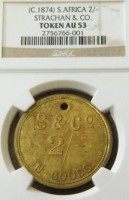 |
History records that the region of Nomansland, south of the Umzimkulu river and Natal and bound to the west by the mighty Drakensberg or Quathlamba (Zulu for ‘The Barrier of Spears’) got its unflattering name after being cleared of African tribes fleeing Chaka's mighty Zulu impis in the 1820s. For over 40 years it became a refuge for small groups of unruly natives and outcasts who survived by stealing cattle from each other and killing... in short it was a no man's land. Into this hell-hole came the Griquas in 1862. The small white population of traders and farmers grew rapidly from this time on drawing Africans from bordering tribal areas such as Pondoland and Nomansland was renamed East Griqualand by the Griquas not long after they settled there.
In the highly sought after book "Kence, the trade tokens of Strachan and Co" (1978) by Scott Balson and Dr Clive Graham the authors describe how South Africa's first indigenous coinage, the Strachan and Co coins had been named "kence" (pronounced kenghle) by the Africans with the onomatopoeic origin being the sound of two of these coins striking each other while they were strung around their necks. Just like the origin of the name of the small southern Natal town of "Ixopo" (eechopo - representing the sound of a cow's hoof going in and out of soft mud) much of the African language in this area was based around sounds. This interesting bit of trivia is our first clue into the important role that these trade token coins played as bona-fide currency in the early development of an area the size of Ireland (north and south) where many thousands of Griquas, a few thousand white settlers and tens of thousands of Africans lived. The Strachan and Co "S&Co" was the first coinage in South Africa deliberately holed to facilitate their safe keeping by the majority of the local population - natives and some Griquas who did not have western clothing or pockets. The background to their success as South Africa's first widely circulating currency is detailed below.
In Robert Ross' highly regarded study "Adam Kok's Griquas", he notes on page 113, In 1872 some twelve trading licenses were issued... this tally excluded the most powerful of the trading interests, namely the firm of Strachan and Co, which, as it included the Secretary to the Government (Brisley) and the Magistrate of Umzimkulu District (Strachan) among its partners, was evidently immune from such indignities as licences. Milner Snell's comprehensive research on the firm and Margaret Rainier's book on Donald Strachan both reflect a different founding date namely the 13th January 1874 - the same year the S&Co trade tokens were first launched. These books follow the earlier similar findings of Balson and Graham's pioneering work, "Kence, the trade tokens of Strachan and Co". Ross was wrong in his assumption over the date the firm was established but correct in his perception of Brisley and Strachan's power in and hold over East Griqualand. Their first trading store at Umzimkulu Drift was forced, because of a shortage of currency, to barter with the locals, but this soon changed.
Donald Strachan's son, Douglas, who took over the running of the business in 1917 noted that the first set of S&Co tokens were issued in the early 1870s (ie January 1874).
Yes, for nearly sixty years (1874 - 1932) the Strachan & Co coins, the kence, South Africa's first indigenous currency, played a major role in the evolving commercial development of a vast and isolated region covering Nomansland, Pondoland , the north eastern Cape and the southern part of Natal.
It is not hard to demonstrate that the first two S&Co sets
(the S&Co and S&Co MH) went much
further 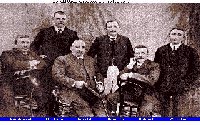 than that
of a traditional trading store token and that these sets, in particular,
were accepted as bona-fide currency over an entire region extending as far
north as Pietermaritzburg, the capital of Natal and as far south as Port
St Johns in the Cape. The first S&Co set released in 1874 were followed about thirty years later by the "MH" set - neither were restricted to "In Goods" the label missing from the coins. As Douglas Strachan said, "These tokens were
accepted everywhere including church collections..." In fact the first set circulated in the same year as theBurgerspond - but outlived, by generations,
the currency and purpose of this highly sought after gold coin. While the Burgerspond rarely, if ever, circulated the S&Co circulated widely in the region between Umzimkhulu to Kokstad and beyond from the mid 1870s.
than that
of a traditional trading store token and that these sets, in particular,
were accepted as bona-fide currency over an entire region extending as far
north as Pietermaritzburg, the capital of Natal and as far south as Port
St Johns in the Cape. The first S&Co set released in 1874 were followed about thirty years later by the "MH" set - neither were restricted to "In Goods" the label missing from the coins. As Douglas Strachan said, "These tokens were
accepted everywhere including church collections..." In fact the first set circulated in the same year as theBurgerspond - but outlived, by generations,
the currency and purpose of this highly sought after gold coin. While the Burgerspond rarely, if ever, circulated the S&Co circulated widely in the region between Umzimkhulu to Kokstad and beyond from the mid 1870s.
Image right: Donald Strachan and sons
In the attached scan of a letterbook, certified a true copy by Ken Strachan, the company confirms in 1907, over 30 years after their introduction, that its tokens could be accepted by a third party. The letter is penned by the company accountant, F L Thring in Ixopo, who refers to payment of their accounts. This was nearly thirty years after the Standard Bank had opened in Kokstad and accepted these coins (see below) and banks like Barclays Bank DCO had subsequently opened in Ixopo. The letter also notes the wide circulation of the coins throughout the general population "should any of the men whose accounts you are dealing with" - further supporting the assertion that the tokens had already been accepted as a practical alternative to scarce coin of the Realm for at least 30 years! (Important verification note: this original letterbook sighted by Balson at Strachan and Co in Umzimkulu in 1978 is now held by the Killie Campbell Library (University of Natal) in Durban.) As noted by Milner Snell in his book very few of Strachan and Co's letter books remain - and none before 1906 - if they had we would be able to present earlier direct references to their coinage.
Balson's book "The Griquas of South Africa and their
money" clearly demonstrates that the first two S&Co sets were
in fact South Africa's first widely circulating indigenous currency -
the book
 exposing the fallacy that the Griqua
Town coins minted in 1815 were ever used by the Griquas.
exposing the fallacy that the Griqua
Town coins minted in 1815 were ever used by the Griquas.
Image right above: just why the Strachan and Co trade tokens are South Africa's most important pre-imperial coinage (click on image to note the geographic area in which they were accepted).
In fact, the Strachan and Co trade tokens broke across the great political divide. Their acceptance as currency preceded the famous Kruger coins of the Zuid Afrikaansche Republiek (1892 to 1899) by nearly 20 years. The S&Co were unlike the exclusive Burgerspond (1874) with its tiny mintage and keep sake rather than tradable value from the date it was released.
Origin of the native name "Kence"
The many thousands of S&Co coins were designed to be used by all races, ages, poor and rich alike - thus the hole in each coin to allow for all levels of society - including for handy storing with the beads commonly worn around African's necks. It was from this practical storage capability that origin of the native name for the S&Co, "KENCE" (pronounced "kenghle" ) can be traced. Its onomatopoeic origin reflects on the unique sound that two S&Co coins made when knocking together as they were worn around the neck. By 1920 the Strachan and Co empire had stores spread right across the region as can be seen in this detailed map of East Griqualand. The S&Co continued to be accepted as circulating coin until 1932 when legislation finally caught up with the loopholes that had allowed them to coexist with official currency. It was at this time, on the 28th December 1932, the convertibility of notes into gold was abolished in South Africa.
| In a letter dd 27 October
1998 from Justice Tom Mullins (who was stationed as Magistrate
in Umzimkulu in 1946) to Donald Kannemeyer (related to Donald Strachan by
marriage) he states when referring to the book
"Kence, the trade tokens of Strachan and
Co"...
The origins of the name "Kence" for the tokens (page 14) is interesting. I have a copy of a very rare book, A Kaffir-English Dictionary by Rev Albert Kropf, published by the Loveday Mission Press in 1899. In it gives i-KenceKence as meaning "a small tinkling bell", and uku-Kenceza as meaning "to tinkle, jingle, ring like a small bell". So the origin of the name seems clearly correct. |
| It cannot be disputed that the region of Nomansland in which the two
Strachan brothers traded from 1858 was extremely isolated and it cannot be
disputed that there was little or no coinage in circulation, in fact some
Griquas are documented as having traded their land in exchange for a bottle
of brandy. Furthermore, there was no official currency during these early
stages in either Nomansland or neighbouring Natal although some British gold
and silver coins were in circulation in the major centres. In about 1860
there was such a dearth of small change throughout the region that tokens
and good-fors were issued by the Durban Club
and then other businesses in Natal's largest city - the port of Durban. It
was at this time that Donald Strachan, one of the earliest traders in the
region of Nomansland, was forced to revert to the unsatisfactory option of
barter trade to run his remotely located trading stores at Umzimkulu. On
one of his regular visits to Durban Donald Strachan, who stayed at the Durban
Club, noted the remarkable success and acceptance of the Durban Club 6d,
according to his grandson, Ken Strachan. The idea of minting their own S&Co
tokens was planted - and the first minting of S&Co tokens was undertaken
resulting in the coin being circulated throughout
a large area as currency. |
In 1870 Indian rupees were imported by speculators and passed off as 2/- pieces. They were extremely unpopular with banks and the government refused to accept them. In ten years they disappeared from circulation. That they survive affirms the now common belief that coin was scarce in the periods from 1874 to 1880 particularly in isolated areas. |
| The shortage of coin in East Griqualand pre-1874 is
best demonstrated by transcribing Extracts from
The Early Annals of Kokstad and East
Griqualand by Rev W Dower:
pp 21: Nearly all business was carried on by barter. Of money there was very little in circulation. Wool, sheep, horses, cattle, goats, skins, timber, eggs, grain, fowl were exchanged for clothing and groceries. Under the Ingeli it was a common sight to see a man laboriously carrying wagon timber or yellow-wood planks to the stores in order to exchange for some articles required for the household. pp23: The church undertook to pay him 150 pounds per annum in cash. The most extraordinary part of it is that there was not that amount of coin in the country at the time. pp 33: So it came to pass that the very first building erected in Kokstad was paid for by a Geneva clerical coat... made by a Durban tailor. all this change in the mid 1870s when Dower notes pp 66, "the sudden ceaseless flow of (Strachan and Co) money into the country, in which, a few years ago there had been none brought, very soon, facilities for spending it". In C L Engelbrecht's excellent work, "Money in South Africa" (1987) he dedicates a chapter (pp129-130) to the role of token coins in overcoming the scarcity of small change in South Africa and writes, "The token money with the longest and perhaps the most interesting history is that of the Strachan and Co... In this isolated part of South Africa, the need for small change presently made itself felt. Change was very scarce indeed, and in Natal, the main source of supply for the business, it was practically unobtainable". |
Consider these comments and facts relating to the shortage of coin in East Griqualand....
| Extracts from a letter by H B Whyte
to Betty Widdicombe dated 17th September 1942
These extracts cover the period 1881 - 1882 in East Griqualand (Whyte owned a trading store "Ensekeni" forty miles west of Umzimkulu Drift and refers to other traders such as G R Scott and Donald Strachan in the letter) Very little imperial currency was in circulation and what there was was subject to a constant drain for hut tax. Wholesale merchants in Durban and Pietermaritzburg from whom we bought most of our supplies would only sell for credit on what seemed to us as exorbitant terms and so obliged us to buy for cash and avoid coming under the thumb of any one. Some produce such as hides and wool brought in ready money and assisted us in overcoming these difficulties in finance. |
The isolation of East Griqualand from any major trading centre is best demonstrated by the precarious week long horse and carriage ride along dangerous and isolated tracks. The journey took the transport riders through the undulating hills between the port of Durban to the capital of Pietermaritzburg before they travelled south through Richmond and across the Umzimkulu river to the remote region of East Griqualand. Strachan's farm Clydesdale was at this gateway with a rudimentary ferry taking the transport riders across the river at Umzimkulu Drift.
The powerbrokers who introduced the currency
 In the early 1870s Donald Strachan
was riding a wave of power in the local political arena - because of time
restraints he played a "sleeping" role in the new company. His brother, Thomas',
new business partner in their business Strachan and Co, George Charles Brisley
(seen right), was a wealthy and well connected man in his own
right - he was a successful trader at Mount Currie, the Griqua Government's
Secretary and in 1869 the Post Master at Mount
Currie. In fact Brisley's crucial role in the fledgling state can
best be understood by his being credited with revising the Griquas' legal
code and constitution as well as setting the parameters for the system of
land ownership (pg 26
Madonela). It was Brisley's connections that saw the S&Co
coins being formally adopted by the Griqua governing authority as the regions
bona-fide currency.
In the early 1870s Donald Strachan
was riding a wave of power in the local political arena - because of time
restraints he played a "sleeping" role in the new company. His brother, Thomas',
new business partner in their business Strachan and Co, George Charles Brisley
(seen right), was a wealthy and well connected man in his own
right - he was a successful trader at Mount Currie, the Griqua Government's
Secretary and in 1869 the Post Master at Mount
Currie. In fact Brisley's crucial role in the fledgling state can
best be understood by his being credited with revising the Griquas' legal
code and constitution as well as setting the parameters for the system of
land ownership (pg 26
Madonela). It was Brisley's connections that saw the S&Co
coins being formally adopted by the Griqua governing authority as the regions
bona-fide currency.
Little is known about Thomas Strachan, but his influence in East Griqualand should not be underplayed as he, like Donald, was offered the position of Magistrate by Adam Kok - turning it down so that he could concentrate on the new business partnership.
Following the untimely death of Thomas in 1879 Donald Strachan took over his share of the business becoming equal partners with Brisley. At this time Strachan's workaholic behaviour is noted in his 1879 diary (the only one to survive). In this year alone he helped prepare the Griqua Commission Report, fought several native wars with his Abaladalozi, farmed, planted trees at his farm Bizweni (Native name for "The place of Meeting") and carried out his Magisterial duties a position he had been honoured with by the Griquas. In Natal the British faced a new serious problem when the Zulus under their king Cetchwayo nearly wiped out Lord Chelmsford's soldiers at Isandhlwana on 22nd January 1879... it was left to Donald Strachan and his Abalandalozi to re-establish the telegraph link between Pietermaritzburg to Pretoria as "local labourers had fled in panic".
The new business partners, Donald Strachan and George Brisley, were trusted by the Griquas acting as official intermediaries for them in negotiations with the Governors of the Cape in the 1870s and early 1880s at the critical time during and after the annexation of the region by the British. This role saw the two men visiting Cape Town on a regular basis. In fact Donald Strachan and Brisley were instrumental in most of the early development of East Griqualand in many ways - and were fully supported in their endeavours by the Griqua Raad who had no idea how to make their new territory commercially viable. Their costly and ill-fated efforts at printing and circulating money in 1868 to ease the shortage of money was quickly halted by Donald Strachan who met with the Volksraad and presented his arguments about the dangers of entertaining a paper-based currency without any financial backing.
The Cape Government also recognised Donald Strachan after 1879 appointing
him as Superintendent of Native Affairs in the East Griqualand region. Strachan
had earlier formed his own military unit called the "Abalandolosi" (also
spelt "abalondilzwe") or "the protectors" whose role could
be likened to a district police force. Sir Walter Stanford, the Chief Magistrate
of East Griqualand in 1886 referred to Donald Strachan
in his reminiscences as "Commandant
Donald Strachan with a regiment of native volunteers from Umzimkulu
(Abalandalozi)". Strachan, as Commandant, is the only soldier listed
under East
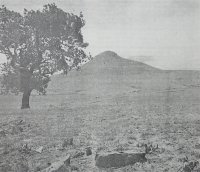 Griqualand Forces as receiving The Cape of Good Hope
General Service Medal (issued between 1880 and 1897) - extraordinarily,
he received a bar for Basutoland and NOT Transkei as his Abalandolosi
were not officially recognised by the Colonial Government.
Griqualand Forces as receiving The Cape of Good Hope
General Service Medal (issued between 1880 and 1897) - extraordinarily,
he received a bar for Basutoland and NOT Transkei as his Abalandolosi
were not officially recognised by the Colonial Government.
Image right: the site of Fort Donald today
In fact Donald Strachan had a "fort" named after him - Fort Donald south of Kokstad - his Abalandalosi would often use this as their base to quell trouble to the East in Pondoland. The fort is described by Margaret Rainier, Strachan's grand daughter, as being a military encampment who's principle feature was a sod wall enclosure measuring 50 feet by 70 feet within a ditch. The "fort" was a defensible position and as a kraal for cattle captured from the Mpondo. An Officers Mess was added later out of stone. The original fort only took two weeks to construct. The site of Fort Donald is on the road between Kokstad and Port St Johns situated on the crest of a mountain before you descend into Pondoland. A store owned by George Philip Pohl stands near the spot.
See also this link for more on the Abalandalosi
 Even
one of the main streets in
Kokstad (seen right) is named after Donald Strachan.
Even
one of the main streets in
Kokstad (seen right) is named after Donald Strachan.
In 1887 Donald Strachan took complete control of the trading store empire in a move which nearly sent him broke - but the S&Co trade tokens continued to be accepted as currency throughout the region and were always honoured by his stores.
From the early 1860s the natives gave Donald Strachan the name of "Madonela" (the place of Donald) a name that carried great respect and affection among the people he had settled with. In fact the Baca people, uniquely, honoured him by making him a white chief, while the Griquas honoured him by appointing him Magistrate in the Umzimkulu region. (Strachan was the only non-Griqua to ever be appointed a Magistrate by the Griquas - notes in Killie Campbell reprint of Dower pp 139). Today the Madonela railway line runs from Ixopo to Pietermaritzburg in recognition of the positive impact that this man had on the peoples of the region.
Furthermore, Donald Strachan's linguistic ability in the local native tongue was widely recognised and documented, for example,
In 1886 Stanford notes, on page 77 of his Reminiscences (Volume two 1885-1929) by J W Macquarrie: Mr Donald Strachan interpreted for me with much ability and patience. Although I speak the Xhosa language, it was necessary for various reasons that all that passed should be in English as well as Xhosa. The Pondos so not themselves speak of their language as Sixhosa but the latter term is in general use among Europeans and substantially Pondos and Xhosas have a common language.
I was indebted, too, to Mr Strachan not only for his excellent interpretation but for valuable information and advice as well.
and
| Madonela, the Autocrat
of Umzimkulu, by Margaret Rainier (extract from pp 53)
It seems to have been during Griffith's Imbizo, the great gathering at Emfundisweni (in 1872), that one of Donald Strachan's brilliant linguistic performances was staged. Surrounded by Africans representing every sept and clan from the whole wide region except the Sotho, he was concealed in a hut; then tribal orators and others with specialised knowledge were invited to interrogate the hidden man, and say exactly which group and locality he came. One after another they tested his use of dialect, idiom, and inflection, and the response to remarks which could only be understood in a specific context. Each in turn, baffled by the fluency of his act, is said to have exclaimed "This is a man of my own people". When at last Strachan emerged perplexity turned to astonishment, to the huge delight of his own attendants - a white man, Madonela, and no other! |
The introduction of the Strachan and Co trade tokens into the money-starved East Griqualand in the mid 1870s by such prominent and well-respected men (Brisley and the Strachan brothers) through their growing network of trading stores was the catalyst for the remote region's growth as the coins were widely accepted as bona-fide "East Griqualand" currency.
Interestingly Brisley, as Secretary of the Griqua Raad, was one of the first beneficiaries of land from the Griquas under Adam Kok when he secured Lot 20 "Wintershoek" in August 1874 - the same year the S&Co token coins were first released.
| Many of the other white traders resented Strachan and
Brisley's power over the Griqua leadership and when the British annexed the
territory in 1875 lodged official complaints against Strachan and Company.
As a result the Commissioners into a report for the Ministerial Department
of Native Affairs (Charles D Griffith, S Probart and T A Cumming) on the
Territory of Griqualand East wrote scathingly about the power Strachan and
Brisley had over the Griqua Raad... (letter dated 22nd October 1875 - page
29 of the report) - this report into land titles was prepared after the
Cape Colony "annexed" the territory.
(Report in the Parliamentary Library, Cape Town) In the course of our investigation into the various grants of land made by the late Griqua Government, among other titles the following were produced:
We are of the opinion that these grants should on no account be confirmed, as it is quite clear that it is a barefaced attempt to give Strachan & Co an unfair monopoly to the inconvenience of the public at large. The grantees claim, we understand, that they are entitled to select the ground along the banks of the river as long as the limits of the extent allow; the outspans themselves are not larger than any should be, and no portion of them should, in our opinion, be alienated from the public, the more so when it is considered that if the ground be taken as stated the grantees will have the monopoly of every part of the river where a drift can be made or a place of business erected on the present line of road from this territory to the neighbouring colony of Natal. What makes these grants still more objectionable is the fact that they were made by the Griqua Government to a firm in which their Secretary, Mr Brisley, was and still is a partner, and this was told to us by Mr Thomas Strachan, the other partner, who informed us that the firm in question consisted of himself and Mr Brisley. We would draw your attention to the date of the grants, the 24th June 1874, a time when a general rush or scramble appears to have been made for grants of land, being immediately after Mr Orpen's announcement here that the Colonial Government meant very shortly to take a more active part in the government of the country. |
Despite the commission and trader's fears both Brisley and
Strachan became major land owners . Even after the land was officially
annexed by the Cape Colonial Government - the Balson Holdings Family
Trust owning the original (stamped) grant to Charles Brisley in
1879 for the farm Rietfontein (literal translation reedy
fountain) - see below.
This Grant to Brisley on perpetual quitrent was authorised at Cape Town on 1st July 1879 and carries the official embossed "Public seal of the settlement at Cape Town". The Grant (full document on right) is signed by the Governor and High Commissioner, Sir Henry Bartle Frere and by the Commissioner of Crown Lands. The deed is for the farm "Rietfontein" which measures 1295 morgen in extent in the Mount Currie (Kokstad) district of East Griqualand. The deed has three revenue stamps, four pound, twelve shilling and three penny.
Brisley was the official who announced in 1872 that the name of the capital
of East Griqualand would be "Kokstad". Images below: key parts of the original land grant to Charles Brisley |
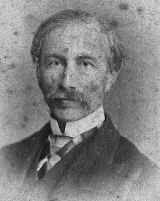 It was
Sir Bartle Frere who requested the Standard Bank to consider opening branches
or agencies at Kokstad and St Johns River without delay in 1878 after East
Griqualand was annexed to the Cape. The bank viewed the matter premature
especially as imperial coinage could not be easily brought into this remote
region. On Frere's insistence the bank sent sent William Henry Doidge, branch
visiting officer, and Thomas Jones David, acting accountant at Colesbeg to
visit the “newly acquired territory annexed by the Cape”
. They arrived in Kokstad in early October 1878, opening the bank's doors
on 25 October 1878 and immediately accepted the trade tokens produced by
the Strachan and Co stores (set one
(S&Co)) as the bona fide currency for the region known as East
Griqualand (see official bank brochure below).
It was
Sir Bartle Frere who requested the Standard Bank to consider opening branches
or agencies at Kokstad and St Johns River without delay in 1878 after East
Griqualand was annexed to the Cape. The bank viewed the matter premature
especially as imperial coinage could not be easily brought into this remote
region. On Frere's insistence the bank sent sent William Henry Doidge, branch
visiting officer, and Thomas Jones David, acting accountant at Colesbeg to
visit the “newly acquired territory annexed by the Cape”
. They arrived in Kokstad in early October 1878, opening the bank's doors
on 25 October 1878 and immediately accepted the trade tokens produced by
the Strachan and Co stores (set one
(S&Co)) as the bona fide currency for the region known as East
Griqualand (see official bank brochure below).
Image Left: Sir Henry Bartle Frere, K.C.B., K.C.G.S.J.
In 1882, nearly ten years after the Strachan coinage were introduced as currency
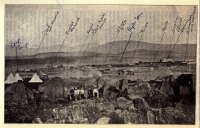 in East Griqualand, Natal's currency was officially
established on a British sterling basis through the Imperial Coinage
Act. The Strachan and Co coinage, similarly based, continued to be circulated
as currency in the East Griqualand, annexed to the
Cape Colony, and south of Natal's borders. It was not affected
by this development and continued to circulate widely (even beyond the region's
borders) until 1932 when token coins were finally outlawed across South Africa.
The ongoing shortage of "official" currency in East Griqualand was not materially
altered by an Act of Parliament.
in East Griqualand, Natal's currency was officially
established on a British sterling basis through the Imperial Coinage
Act. The Strachan and Co coinage, similarly based, continued to be circulated
as currency in the East Griqualand, annexed to the
Cape Colony, and south of Natal's borders. It was not affected
by this development and continued to circulate widely (even beyond the region's
borders) until 1932 when token coins were finally outlawed across South Africa.
The ongoing shortage of "official" currency in East Griqualand was not materially
altered by an Act of Parliament.
Image right above: Kokstad taken from Stony Kopje in 1878 before the Standard Bank was established
In the booklet produced by the Standard Bank in Kokstad
in 2003 to commemorate the branch's 125th anniversary the bank notes,
that the Strachan and Co coins were accepted as currency. The
booklet also notes that it was not until the late 1890s when "many black
inhabitants were recruited to work on the mines on the Witwatersrand that
a large amount of money was at last brought
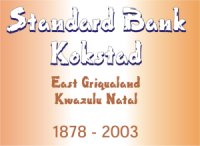 into circulation (in East Griqualand)." (The Standard
Bank was the only bank in East Griqualand until 1919 when the National Bank
opened its doors in Kokstad).
into circulation (in East Griqualand)." (The Standard
Bank was the only bank in East Griqualand until 1919 when the National Bank
opened its doors in Kokstad).
Click on the image right to see the relevant extract of the Standard Bank's brochure.
The Standard Bank in Kokstad was so strongly supported that its competitor, the Bank of Africa, did not bother opening bank there or at Ixopo in Southern Natal. The Bank of Africa became merged with the National Bank of South Africa which itself was incorporated into Barclays Bank (DCO) in 1925, which is now called in a nice but untrue twist the First National Bank of South Africa.
A very rare cheque from the Bank Of Africa, drawn on its Pietermaritzburg Branch. It is dated 5th August (July Crossed-Out) 1881 and is payable to "W. Shepherd (Representatives)". It is for the sum of Twelve Shillings (12/-). It is signed "Matterson Bros." It is stamped "Paid, Bank Of Africa Ltd., Pietermaritzburg, 11th August 1881" and countersigned on the back by the representatives of the Payee W. Shepherd.
 |
 |
At the time of Donald Strachan's death, in 1915, the Strachan and Co empire included some fourteen stores spread across East Griqualand.
These were: Border Cash, Bossenfontein, Brooklands, Cabane, Clydesdale (Umzimkulu), Gugweni, Ibisi, Kromhoek, Mahobe, Memeza, Mfulamuhle, Mountain Home, Plain Hill and Rietvlei.
The exact location of these stores in East Griqualand can be seen at this link
By the 1950s the Strachan and Co empire was at its height with twenty stores: Baganyama, Bont Rand*, Bossonfontein, Brooklands, Cabane, Cancele*, Clydesdale, Cupar*, Gugweni, Himeville, Ibisi, Kroemhoek, Mahobe, Memeza, Mfulamuhle, Mountain Home, Plain Hill, Rietvlei, Swartberg and Taylerville.
In the period 1874 to 1932 an estimated 50,000 to 100,000 Strachan and Co tokens were issued with a face value of between £3,000 to £5,000. The commoner varieties have only recently become more readily available to numismatists with large finds of thousands of Strachan and Co tokens being made in recent years. Despite these finds the price of these coins has continued to rise as numismatists recognise the rightful place of the Strachan and Co trade tokens as bona fide circulating currency.
In 1984 the Strachan and Co empire was liquidated after East Griqualand was turned into the independent homeland of Transkei under the Apartheid regime. Ken Strachan took the tokens counted by Scott Balson in 1976 with him and had them melted down after he settled in Pietermaritzburg for his retirement - donating the proceeds of the brass to a local church.
| Dear Scott
My grandfather worked for Strachan & Co. in the 1930s and later for James Cole before buying his own store in the Umzimkulu district. After the introduction of the homeland systen he bought a store on the Natal side of the river on the road beyond Madonela station, which was where I spent the first few years of the life. I am presently in the process of privately publishing a limited edition work on the white traders and farmers of the Umzimkulu district. It will include James Cole, the Staffords etc. Ken Strachan had the remaining tokens melted down and the money he made from selling the brass was given to St Peter's in Pietermaritzburg*.
Regards |
*Purchased from F C Larkan in 1929
To put the argument that the Strachan and Co token coins were accepted as currency throughout this district into perspective we need to look at key supporting evidence.
Firstly, Donald Strachan was a man of immense political power in the region following his appointment as the Cape's Superintendent of Native Affairs for East Griqualand, and also immense judicial power as he had been personally appointed by the Griqua leader, Adam Kok, as Umzimkulu's resident Magistrate. His brother Thomas' wealthy partner, Charles Brisley, as the Griqua Government Secretary also had tremendous influence and contacts right to the top. When Thomas died in 1879 Donald took over his shareholding in the company.
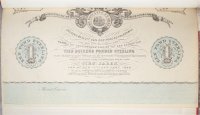 Secondly, as Ken Strachan
told Scott Balson, Donald Strachan as Magistrate in Umzimkulu personally
intervened and prevented the Griquas of East Griqualand from introducing
their own one pound note in 1868. The Griqua Raad were frustrated by the
highly unsatisfactory system of barter forced on the people because there
was absolutely no currency in this isolated region. The notes were withdrawn
as there was no financial basis on which to support this expensive but delusional
exercise (of the one pound note) ordered by the Griqua Raad (Government).
The notes were later burnt*.
More at this link.
Secondly, as Ken Strachan
told Scott Balson, Donald Strachan as Magistrate in Umzimkulu personally
intervened and prevented the Griquas of East Griqualand from introducing
their own one pound note in 1868. The Griqua Raad were frustrated by the
highly unsatisfactory system of barter forced on the people because there
was absolutely no currency in this isolated region. The notes were withdrawn
as there was no financial basis on which to support this expensive but delusional
exercise (of the one pound note) ordered by the Griqua Raad (Government).
The notes were later burnt*.
More at this link.
However, the seed had been planted in Donald and Thomas Strachans' minds and shortly thereafter they launched their own S&Co coinage. They did this after seeing for themselves the success and acceptance of the Durban Club and other tokens in Natal.
*Copies of the extremely rare unissued one pound note are carried in the original 1902 publication of Rev W Dower's book "The Early Annals of Kokstad and East Griqualand". Dower notes on page 129 that Strachan gave him a few bank notes to include in the book. The Balson Holdings Family Trust holds three copies of Dower's original book including one signed by Dower's son. The trust also holds copies of the 1978 Killie Campbell reprint with notes which were used for research purposes.
Thirdly, the manner in which the Strachan & Co business survived in such an isolated area despite severe economic hardship in the 1880s is, in itself, a trading miracle. It was the release of the first S&Co trade tokens which created the lifeline for the Strachan stores as they were mostly used for trade outside the stores. The coins in circulation generating credit that the stores were able to use to get through a recession in the 1880s that saw many bankruptcies among the traders of East Griqualand. In the Standard Bank's commemorative booklet they note, from their archives, how difficult it was for most traders at this time to survive in these isolated outposts and that the Strachan and Co coins were accepted and distributed by the bank as the local currency. (You can download the bank's document in PDF form here).
Fourth, as a result of this financial stability its role, with its many stores spread across East Griqualand, Strachan and Co through its tokens evolved into the region's "central banker" from the mid 1870s to the 1930s. During this time over 20 stores were established - many of the stores, like those of F C Larkan, being acquired by Strachan when other traders were under financial duress. The towns of Kokstad and Matatiele, in the middle of nowhere, flourished as trading centres thanks to the wide acceptance of the Strachan coinage. Economies of little villages like Ixopo in Southern Natal thrived thanks to the coinage. (Ixopo is the home of Alan Paton's famous book "Cry the beloved country" about racial injustice - with Stephen Kumalo, a Zulu pastor as its central character. It has sold millions of copies.)
Quote: In the 1920s, Ixopo was a special place for the young Alan Paton. It was here that he was sent by the Natal Education Department as a maths and science teacher at the high school. He was 22 and described himself as "virginal and shy".
He loved Ixopo from the start. He fell in love with the lovely rolling hills that encircle it - and he fell in love with a woman for the first time. He met Dorrie Lusted while playing social tennis, describing her as "something like an urchin, full of mischief and zest and repartee". But she was married. Nevertheless, she was to become my mother.
Fifth, local traders like James Cole, Dawood Amod, F C Larkan, St Faiths, G Roe Scott, Edward Sprag, WW Phillips, Creighton and Dennis , J Hagan, St Barnabus Anglican Mission and H J Creighton issued their own trade tokens in an attempt to emulate the earlier success of Strachan's coinage - they all failed and their coinage is extremely hard to come by today. The trade tokens issued by Mrs Frances Charlotte Larkan and James Cole were the most successful after the trade tokens introduced by Donald Strachan.
In the case of James Cole author Carel Birkby notes in his book "Zulu Journey" (following his interview with him in 1937) that Cole's tokens were also widely accepted as currency in East Griqualand as cash by the natives because of the shortage of currency in that region.
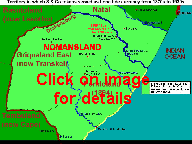 Sixth,
the large geographic area that the S&Co tokens were accepted as currency
far and wide thanks to the wide distribution of their stores (roughly
85,000 square kilometers (32,600 square miles) and at that time inhabited
by a population numbering well over 100,000 (about 9,000 white settlers).
This area exceeded the size and population of independent countries
like Lesotho and Swaziland and is similar in area to Ireland All these
independent countries now have their own coinage.
(Take this link to
see the graphic geographic region in South Africa where the S&Co
tokens were accepted as currency.) Click on the image on the right to
see this area in detail. To see the geographic aerial satellite map
of the region that the S&Co tokens were used in South Africa
take this link, and the location of the Strachan
and Co stores across the width and breadth of East
Griqualand at this link.
Sixth,
the large geographic area that the S&Co tokens were accepted as currency
far and wide thanks to the wide distribution of their stores (roughly
85,000 square kilometers (32,600 square miles) and at that time inhabited
by a population numbering well over 100,000 (about 9,000 white settlers).
This area exceeded the size and population of independent countries
like Lesotho and Swaziland and is similar in area to Ireland All these
independent countries now have their own coinage.
(Take this link to
see the graphic geographic region in South Africa where the S&Co
tokens were accepted as currency.) Click on the image on the right to
see this area in detail. To see the geographic aerial satellite map
of the region that the S&Co tokens were used in South Africa
take this link, and the location of the Strachan
and Co stores across the width and breadth of East
Griqualand at this link.
Seventh, as recorded by Douglas Strachan, the isolated communities depended upon the S&Co currency which was used for a multiple of purposes from paying taxes to buying goods to making a donation at the local church.
Eighth, it is clear that up to one hundred thousand Strachan and Co tokens worth thousands of pounds were issued between 1874 and 1932. The actual numbers minted are not recorded by the company but the accurate count done by Balson of over 20,000 tokens in 1976 gives a clear pointer to the proportional numbers of tokens making up the sixteen different token types. Recent new finds of large caches of S&Co tokens, including verified reports of thousands of tokens in the possession of a Policeman in southern Natal, and a further large find of thousands of scrapped Strachan tokens which are currently being sold on the Internet reflect a verifiable estimate of over 50,000 S&Co tokens being minted . This is far more than the requirement of the company's trading stores scattered across East Griqualand if their purpose had been restricted in scope to trade with the business. It is believed that most of these tokens have been lost or scrapped over time, however, it is clear that there could conceivably be thousands more still to be found. The sheer volume of these coins underwrites their real purpose as the accepted currency of the region. (Note the "MH" set remains extremely rare and with the variety three 1/- are the hardest pieces to acquire with less than 100 complete sets of the sixteen pieces in existence).
Ninth, the earlier S&Co and S&Co "MH" sets made no reference to "in goods" - an interesting omission! So from 1874 to 1904 at least, they were struck for the primary purpose of circulating currency.
Tenth, the powerful positions of the partners in Strachan and Co, Thomas and Donald Strachan and Charles Brisley, who acted on behalf of the Griqua Raad in all matters pertaining to the development of East Griqualand and as the Griqua's messengers in all communications with the Governor of the Cape. Clearly their coinage, in light of the inept proceedings of the Griqua "parliament", described at this link, was sanctioned and accepted by the Raad as a practical solution to the shortage of other forms of circulating coinage in the region.
Eleventh, in the Standard Bank's commemorative booklet they note, from their archives, how difficult it was for most traders at this time to survive in these isolated outposts and that the Strachan and Co coins were accepted and distributed by the bank as the local currency. (You can download the bank's document in PDF form here).
Twelfth, unlike coins that were never circulated widely, most S&Co coins are worn - many being just "G" or "Good" (a misnomer for the uninitiated in the fineries of numismatics). S&Co pieces in Unc are practically unheard of - a few pieces in this condition are held by the Balson Holdings Family Trust.
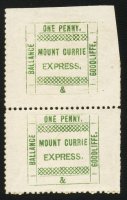 Thirteenth, the acceptance
of the Griqua Government of the Mount Currie Express
stamp (seen right) in 1874 - the same year as the Strachan and Co
trade tokens appeared reflects this evolving independent territory embracing
private business taking on the load and cost of supplying stamps and money
to ease the burden of their isolated citizens. The Raad could not even afford
tea for its sitting so how could it afford to create that costly infrastructure?
It couldn't.
Thirteenth, the acceptance
of the Griqua Government of the Mount Currie Express
stamp (seen right) in 1874 - the same year as the Strachan and Co
trade tokens appeared reflects this evolving independent territory embracing
private business taking on the load and cost of supplying stamps and money
to ease the burden of their isolated citizens. The Raad could not even afford
tea for its sitting so how could it afford to create that costly infrastructure?
It couldn't.
Fourteenth, the general acceptance of the Strachan and Co tokens is referred to regularly by various generations of the Strachan family - from Donald's sons to his grand son, Ken Strachan in the book No Mans Land - Griqualand, Margaret Rainier in her book on Donald Strachan and by Ken Strachan's dear friend, Milner Snell, in his book on Strachan and Company.
Fifteenth, the holing of the coins from 1874 to facilitate storage and safe keeping by the non-white population was so successful that many other trade tokens in this area followed the lead by Strachan and Co - holing their coins as well (eg H J Creighton, Dawood Amod, James Cole, St Faiths, and many of the F C Larkan pieces).
Last but not least Key Strachan family members involved in the company confirm the launch of the S&Co in 1874 and refer to the coins being "accepted everywhere even in church collections" - page 9 of the book "Kence, the trade tokens of Strachan and Co" published in 1978 by Scott Balson and Prof Clive Graham.
The Strachan and Co coins are as much, if not more so, a major part of the South African numismatic story as the "ZAR" Coinage or the highly sought after Burgerspond.
Individual Strachan & Co tokens are rarely sold today. The growing global demand for this currency will mean that the prices will rise. It is estimated that there are about 8,000 to 20,000 individual S&Co token pieces surviving today.
Balson agrees with Kokstad based historian , Milner Snell, that the following are the dates for the four Strachan sets:
References:
The collection of books at this link, but most
specifically,
The Early Annals of Kokstad and Griqualand East
by Rev W Dower (published 1902) and
reprint by Killie Campbell Africana Library
(Durban) in 1978
"Kence" the trade tokens of Strachan and
Company - Scott Balson and Dr C Graham (1978)
The Griquas of South Africa and their money
- Scott Balson (2004)
Standard Bank Kokstad's 125th Anniversary
brochure (2003)
Stanford's Reminiscences
by J W Macquarrie (1962) published by the Van Riebeeck Society, Cape Town
Madonela - Donald Strachan: Autocrat
of Umzimkulu by Margaret Rainier (published 2003)
Money in South Africa by C L
Engelbrecht (1987)
Strachan and Co, Merchants and
Traders by Milner Snell (2005)